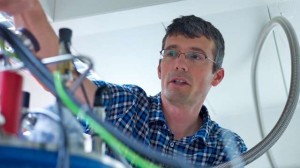IBM researchers are claiming a huge breakthrough in spintronics, a technology that could significantly boost capacity and lower power use of memory and storage devices, according to a paper published in science journal Nature.
Spintronics, short for “spin transport electronics,” uses the natural spin of electrons within a magnetic field in combination with a read/write head to lay down and read back bits of data on semiconductor material.
By changing an electron’s axis in an up or down orientation – all relative to the space in which it exists — physicists are able to have it represent bits of data. For example, an electron on an upward axis is a one; and an electron on a downward axis is a zero.
Spintronics has long faced an intrinsic problem because electrons have only held an “up or down” orientation for 100 picoseconds. A picosecond is one trillionth of a second (one thousandth of a nanosecond). One hundred picoseconds is not enough time for a compute cycle, so transistors cannot complete a compute function and data storage is not persistent.
In the study published in Nature, IBM Research and the Solid State Physics Laboratory at ETH Zurich announced they had found a way to synchronise electrons, which could extend their spin lifetime by 30 times to 1.1 nanoseconds, the time it takes for a 1 GHz processor to cycle.
The IBM scientists used ultra short laser pulses to monitor the evolution of thousands of electron spins that were created simultaneously in a very small spot, said Gian Salis, co-author of the Nature paper and a scientist in the Physics of Nanoscale Systems research group at IBM Research.
Usually, such spins find electrons randomly rotating and quickly losing their orientation. In this study, IBM and ETH researchers found, for the first time, how to arrange the spins neatly into a regular stripe-like pattern — the so-called persistent spin helix.
The concept of locking the spin rotation was originally proposed as a theory back in 2003, Salis said. Since then, some experiments found indications of such locking, but the process had never been directly observed until now, he added.
“These rotations of direction of spin were completely uncorrelated,” Salis said. “Now we can synchronise this rotation, so they don’t lose their spin but also rotate like a dance, all in one direction.”
“We’ve shown we completely understand what’s going on there, and we’ve proven that the theory works,” he added.
The IBM researchers have been using gallium arsenide, a material commonly used today in electronics, diodes and solar cells, as their primary semiconductor material.
Today’s computing technology encodes and processes data by the electrical charge of electrons. However, researchers say the technique becomes limited as semiconductor dimensions shrink to the point where the flow of electrons can no longer be controlled.
For example, NAND flash products already use circuitry that is less than 20 nanometers in width, which is approaching atomic size. Spintronics could surmount this memory impasse by harnessing the spin of electrons instead of their charge.
The new understanding of spintronics can not only give scientists unprecedented control over the magnetic movements inside devices, but also opens new possibilities for creating more energy efficient electronic devices.
IBM is not alone in its pursuit of spintronics technology research.
Three years ago, physicists from the Institute of Materials Physics and Chemistry in Strasbourg, France, built new laser technology on the foundation of spintronics and won the 2007 Nobel physics prize for the effort.
The French physicists discovered a way to use lasers to accelerate storage I/O on hard discs by up to 100,000 times current read/write methods.
A problem with spintronics had been the slow speed of magnetic sensors that are used to detect bits of data. But according to the 2007 French study, published in the scientific journal Nature Physics, the team used a “Femtosecond” laser, which produces super-fast laser bursts to alter electron spin, speeding up the read/write process.
IBM’s researchers said their breakthrough opens the door for efforts to create transistors and non-volatile storage that would use considerably less power than today’s NAND flash technology.
However, one rather large sticking point is that researchers haven’t been able to produce their results at room temperature, an important requirement for producing a viable processor or memory device. Currently, experiments take place at very low temperatures of 40 degrees Kelvin, or -233 Celsius, -387 Fahrenheit.
“There’s no device for this yet, but it’s a breakthrough in that we now know how to increase the electron’s spin lifetime in channel,” Sails said. “Next, one thing we’d really like to do is increase that [spin lifetime] by a factor of 30.”






